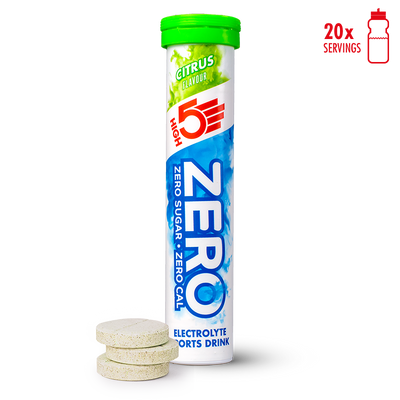Deciding to run a half marathon is a big step and a really exciting challenge. With the growing popularity of long-distance running, more and more people are drawn to running longer races like full and half marathons.
But if you're new to this, training for a half marathon can be challenging. In fact, a study found that over 65% of runners quit during a marathon after they hit the halfway mark.
That's why it's so important to have a well-structured half marathon training plan made for beginners. This plan will help guide you and make sure you're on the right track. It should focus on building endurance and pace and understanding the unique demands of such a long-distance race.
Pro Tip: As you are getting ready to run a half marathon, make sure you have a comprehensive half marathon nutrition plan, too, to fuel your running sessions.
Understanding the Basics of a Half Marathon Training

A half marathon is a mid-range race perfect to bridge the gap between a 5k and a full marathon. When the distance stretches to 13.1 miles compared to 5k or 10k, it brings unique training challenges for the runners.
A training plan for a half marathon usually consists of various elements, including strength training, cross-training days, and recovery runs. You can also have a look at what to eat before a half marathon to ensure proper pre-run nutrition.
Beginner runners should follow a half marathon training schedule around their half marathon goal. From cross-training sessions to training runs and race day strategies to cross the finish line, everything needs to be planned out in advance.
Half Marathon Training Plan Summary:
Below, we have added a summary to introduce you to half marathon training and the ultimate half marathon training plan strategy for you:
- Half Marathon Essentials: A structured half marathon training plan is crucial for beginners, focusing on endurance, conversational pace, and understanding the 13.1-mile challenge.
- 16-Week Training Schedule: Recommended for many runners, this schedule allows for a gradual build-up to the half marathon distance, accommodating a busy lifestyle.
- Initial Weeks (1-4): Establish a strong running base with a mix of short and long training runs, increasing distance to adapt to the half marathon's demands.
- Mid Training (5-8): Introduce interval training to boost cardiovascular fitness, with sessions that mix high-intensity running and recovery.
- Later Stages (9-12): Increase mileage through progressive overload in training runs, preparing muscles and stamina for the half marathon race.
- Final Phase (13-16): Fine-tune performance and start tapering, reducing volume and intensity to reach the finish line rested and ready.
- Running Gear and Nutrition: Choosing the right running shoes and adhering to a half marathon nutrition plan support your training efforts.
- From 5k to Half Marathon: Transition involves setting realistic goals, mental preparation, and adjusting to longer distances while maintaining a conversational pace.
Half Marathon Training Plan 16 Weeks: Steps for Building Endurance
The recommended training period for beginners to prepare for a half marathon is between 12-16 weeks. Although there is no one-fits-all training schedule to prepare for a half marathon, you can always customise it for your needs. We have prepared a comprehensive 16-week plan so that you are fully prepared on your race day.
Here is how you can proceed following this training program.
Week 1-4: Building Endurance
The first four weeks of training are focused on building endurance. It involves strengthening your running foundation through diverse running techniques. This foundational phase aims to establish a robust running base, which is crucial for tackling the upcoming challenges.
Here is what you can do during this base-building phase:
Understand Base Building Philosophy
- Embrace the concept of "base building" as the cornerstone of this phase.
- Understand that a strong base sets the stage for more intense training in the subsequent weeks.
Practise a Mix of Short and Long Runs
- Introduce a balanced combination of short and long runs to acclimate your body to varying distances (ensure you increase the half marathon distance gradually).
- Start with short runs of 2-3 miles while gradually increasing their distance and incorporating long runs of 5-6 miles to build endurance gradually.
- Short runs build consistency, while long runs prepare your muscles for increased mileage.
Adaptation to Increased Mileage
- Allow your body to adapt to the heightened mileage demands gradually.
- Incremental increases in distance prevent overexertion and reduce the risk of injury.
Make sure you stay well-hydrated before, during, and after your training sessions with HIGH5 hydration products. By incorporating these strategies, you lay the groundwork for a resilient and enduring running foundation, setting the tone for the coming weeks.
Week 5-8: Introducing Intervals
At the end of the fourth week, you will have built the endurance you need for running workouts. Now, it's time to incorporate interval training to enhance your cardiovascular fitness. After building endurance for four weeks, here are the steps to follow for the next four weeks.
Structured Interval Sessions
- Infuse your training regimen with structured interval sessions designed to push your cardiovascular limits.
- These sessions involve alternating between periods of high-intensity running and active recovery.
- For instance, warm up with 10 minutes of easy jogging, then run at a comfortably hard pace for 20-30 minutes. End with 4-5 minutes of jogging at a comfortable pace and cool down with 10 minutes of jogging for recovery.
Gradually Increase your Mileage
- Increase the length of your short and long runs to build stamina for the race day.
- Vary running between 4-5 miles in short running sessions and 7-9 miles in long running sessions.
- Include walking breaks in between running sessions for active recovery.
Understand the Importance of Diversity
- Incorporate diversity in your training to prevent monotony and engage different muscle groups, including quads, calves, hamstrings, and core muscles.
- A varied workout routine, including enough rest, cross-training, and high-intensity training days, enhances overall fitness.
- It helps you prevent muscle cramps while running and contributes to a well-rounded approach.
By integrating these interval training elements, you not only boost cardiovascular fitness but also infuse an element of excitement into your training routine. This free half marathon training plan ensures a balanced and diverse approach to your preparation.

Week 9-12: Increasing Mileage
After two months of training, you will feel a difference in yourself. Your endurance, stamina, and speed would be significantly different from pre-training weeks. It’s time to focus on gradually increasing the mileage over these weeks.
Many trainees begin their training 8-9 weeks before a half marathon. If you are a beginner, this approach can lead to various running issues and affect your performance.
Progressive Overload
- Implement a strategy of progressive overload, incrementally increasing the distance you cover.
- Aim to run 10-12 miles, switching between short and long runs throughout the weeks.
- This intentional approach ensures that your body adapts gradually, minimising the risks of overtraining.
Listening to Your Body
- Learn to tune into your body’s signals during this phase to increase the mileage accordingly.
- Be mindful of any signs of fatigue or strain, allowing for adjustments in training intensity or duration.
Take Strategic Rest Days
- Not all days are intensive training days. Sometimes, you must incorporate strategic rest days into your training schedule to allow for recovery and prevent burnout.
- Rest days ensure that your body has time to repair and strengthen.
- You can either cross-train or opt for complete rest if you want to.
With these steps, you can benefit from the principles of progressive overload to navigate this phase effectively.
Week 13-16: Fine Tuning and Tapering
Finally, it’s time to enter the final phase of the training. Now that you are in the final phase of training, you can opt for a gradual reduction in your speed work. The final four weeks focus on improving your performance and incorporating tapering into your training.
Here is what you can do at this stage:
Go for Strategic Tapering
- Tapering refers to gradually reducing the volume and intensity of training before the race.
- Strategically reduce the training intensity from 12 miles to 9 miles a week before the race.
- Ensure maintaining overall fitness levels to allow your body to recover, adapt, and prepare for the race.
Maintain Fitness, Reduce Intensity
- Using the tapering strategies, deliberately decrease the volume and intensity of your workouts as the race draws near.
- This reduced intensity aims to allow your body to recover from the training sessions. This way, you arrive at the race day rested and ready.
Pro Tip: Use HIGH5 recovery products at this stage to enhance the effectiveness of your recovery strategies.
Enjoy the Benefits of Well-Timed Taper
- A well-timed taper after running consistently gives your body enough recovery days by improving glycogen stores, reducing muscle fatigue, and enhancing mental readiness.
- This strategy can prove to be a key component of a successful half marathon strategy through injury prevention.
If you have been following the training plan properly, you will see visible results during the final weeks. Not only will your endurance improve, but also your mental strength will increase.
Pro Tip: Incorporate a half marathon nutrition plan in your half marathon training plans to ensure you provide your body with the required nutrients it needs for half marathon training.
3 Steps for Transitioning from 5k to Half Marathon Training
Have you already been running a 5k and now want to transition to half marathon training? Having some experience in long-distance running makes it easier to transition from one level to another.
The following are the three easy steps to help you transition from a 5k to a half marathon plan swiftly.
1. Set Realistic Goals
Transitioning from a 5k to a half marathon requires setting realistic goals. They provide you with a measurable way to track your performance and stay motivated throughout the training. On the other hand, setting unrealistic goals can lead to overtraining and discouragement.
Here are some tips to help you set your goals mindfully:
- Assess Your Current Fitness Level: Begin by evaluating your current running capacity. Understand your typical 5k pace, weekly mileage, and any recent changes in your running routine as a first-timer. Build realistic goals for strength training based on your existing strengths.
- Consider Your Running Experience: Take into account your experience with long-distance running. If the transition from 5k to a half marathon is relatively new, start with conservative goals and gradually progress. For seasoned runners, goals can be more ambitious but still realistic.
- Factor in Training Time: Evaluate the time available for training. Realistic goals should align with the duration of your training plan. Consider potential time constraints, work commitments, and other responsibilities when setting milestones to become a better runner.
- Integrate SMART Goal Setting: Utilise the SMART criteria for goal setting—Specific, Measurable, Achievable, Relevant, and Time-bound. Define specific outcomes, establish measurable criteria, ensure relevance to your overall objective, and set a realistic timeframe.
- Focus on Consistency: Prioritise consistency in your training routine. Realistic goals should account for regularity in your workouts. Strive to maintain a steady progression, avoiding abrupt or extreme changes in your running routine.
- Understand the Incremental Nature of Progress: Recognise that progress in long-distance running is often incremental. Set small, achievable milestones along the way to the half marathon. Celebrate these milestones to stay motivated and build confidence.
2. Mental Preparedness
The second step to switching to a half marathon training plan from 5k is to prepare your mind. Due to a significant increase in distance and training challenges, you need mental strength to sustain motivation and discipline throughout the training. It also helps you cope with the physical and mental fatigue that comes with running long distances.
Some mental preparedness techniques you can use include;
- Visualisation: Dedicate some time before the training to envision yourself completing your goal to run a half marathon. Imagine the details to build a positive mental image, fostering confidence and reducing anxiety.
- Mindful Running: Another popular method for mind preparedness is mindful running. It refers to staying focused on your running, breathing, stride, and surroundings instead of getting lost in thoughts.
- Goal Setting Sessions: Dedicate some time to define your goals, evaluate your performance, and then refine your goals. A half marathon is different from a 5k in terms of distance and training requirements. So, you must define and adjust your goals based on your performance.
3. Listen to Your Body
One of the most important things to remember when transitioning from a 5k to a half marathon training plan is to listen to your body. Since you have to cover a longer distance in a half marathon, your body requires more energy, resilience, and effort.
If you’re feeling excessively tired or sore, have a rest for a day. Don’t push yourself too hard to be a better runner; that might lead to an injury. If you encounter any problem switching your marathon level, you must consult an expert or work with a running coach. They can help create a custom training plan according to your fitness level and goals.
Besides these steps, ensure that your 5k to half marathon training plan includes a gradual increase in mileage, incorporates a variety of running workouts, and allows for adequate rest and recovery. Proper planning can reduce injury risk and make your training plans a success.
8 Week Half Marathon Training Plan for Beginners: Tailor it to Your Goals
If you are in a time crunch and want to prepare for a half marathon within a shorter time span, you can opt for an 8-week training program. Make sure you consult an experienced runner or a specialist to assess the viability of an 8-week plan for your goals.
Here’s how an 8-week half marathon training plan would look tailored for beginner runners to help them be better runners. Please note that this plan assumes that you can already comfortably run 3 miles (5k) at the start. Adjust the distances based on your current fitness level.
Week 1-2: Foundation Building
- Day 1: 3 miles at an easy pace
- Day 2: 2 miles with intervals (run 0.5 miles at a moderate pace, then walk for 1 minute; repeat)
- Day 3: Rest or light cross-training (cycling, swimming, or yoga)
- Day 4: 3.5 miles at an easy pace
- Day 5: 2 miles with intervals
- Day 6: Rest
- Day 7: 4 miles at an easy pace
Week 3-4: Introducing Longer Runs
- Day 1: 3 miles at an easy pace
- Day 2: 2 miles with intervals
- Day 3: Rest or light cross-training
- Day 4: 4 miles at an easy pace
- Day 5: 2.5 miles with intervals
- Day 6: Rest
- Day 7: 5 miles at an easy pace
Week 5-6: Building Endurance
- Day 1: 4 miles at an easy pace
- Day 2: 3 miles with intervals
- Day 3: Rest or light cross-training
- Day 4: 5 miles at an easy pace
- Day 5: 3 miles with intervals
- Day 6: Rest
- Day 7: 6 miles at an easy pace
Week 7: Tapering Down
- Day 1: 3 miles at an easy pace
- Day 2: 2 miles with intervals
- Day 3: Rest or light cross-training
- Day 4: 4 miles at an easy pace
- Day 5: 2 miles with intervals
- Day 6: Rest
- Day 7: 8 miles at an easy pace
Week 8: Race Week
- Day 1: 3 miles at an easy pace
- Day 2: Rest
- Day 3: 2 miles with intervals
- Day 4: Rest
- Day 5: 2 miles at an easy pace
- Day 6: Rest
- Race Day: 13.1 miles (Take it easy, run the majority distance at a conversational pace, and enjoy the experience)
Remember to stay hydrated, listen to your body, and consult with a healthcare professional before starting a new exercise program. Adjust the plan based on your fitness level, and don't hesitate to take extra rest days if needed. Good luck with your half marathon training!
Half Marathon Training Plan for Beginners - Conclusion
A well-structured half marathon training plan is not only about physical preparedness but also about mental resilience and strategic planning. Whether you are transitioning from running a 5k to half marathon or are a complete beginner, training is crucial. With the right half marathon training plan for beginners, you know how to navigate through your training to become a champion.
To boost your energy levels during training and quick recovery after the race, keep your energy drinks and recovery supplements with you. With the right training and preparation, you can ace any half marathon trail easily.
Frequently Asked Questions
How long do you need to start training for a half marathon?
The recommended training period for a half marathon is typically around 12 to 16 weeks, depending on your current fitness level and running experience. However, half marathon training plans can vary depending on personal preference and goals. You can decide your training schedule according to yours.
How do I train for a half marathon with no experience?
To train for a half marathon with no experience, start with a beginner-friendly training plan, such as our 1-week training plan, that gradually increases mileage. Focus on building endurance through a mix of running and walking, gradually increasing the distance each week. With consistent training and dedication, it is possible to go from a sedentary lifestyle to completing a half marathon in six months.
Can I train for a half marathon in six weeks?
While it's not ideal, some individuals with a baseline level of fitness might be able to complete a half marathon with a condensed six-week training plan. However, longer training periods are generally recommended.
How do you know if you are ready for a half marathon?
You can know that you are ready for a half marathon if you can comfortably run at least 10 miles per week. Focus on gradually building your goal pace to 30-40 minutes for 6-8 miles to feel physically prepared for the distance.
How do I survive my first half marathon?
To survive your first half marathon, pace yourself, stay hydrated, fuel properly, and listen to your body. Train adequately beforehand, and don't forget to enjoy the experience. To get in shape for a half marathon, follow a structured training plan, gradually increase your mileage, include cross-training exercises, prioritise rest, and focus on proper nutrition.
Can I take a week off during half marathon training?
Yes, you can take a week off during half marathon training. Taking a week off during half marathon training, known as a "down week," can be beneficial for recovery. Ensure it aligns with your overall training plan and doesn't compromise your progress.
Can I go from 10k to half marathon in six weeks?
Yes, you can go from 10k to a half marathon in six weeks. Transitioning from a 10k to a half marathon in six weeks is possible for runners who can already run a 10k. However, you must ensure consistent training and a proper diet to build a solid running foundation.
What is a half marathon pace?
Half marathon pace varies among individuals but is typically slightly slower than the 10k pace. It's a pace that you can sustain for the entire 13.1-mile distance.








